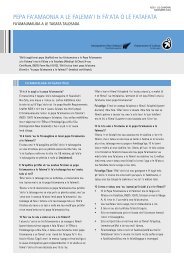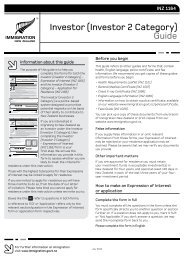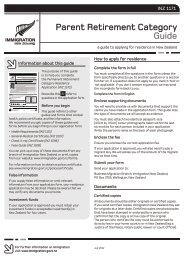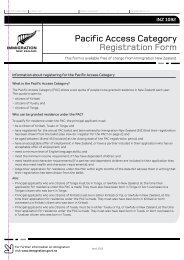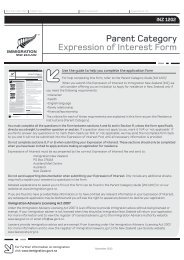Immigration Guide for Employers - Immigration New Zealand
Immigration Guide for Employers - Immigration New Zealand
Immigration Guide for Employers - Immigration New Zealand
Create successful ePaper yourself
Turn your PDF publications into a flip-book with our unique Google optimized e-Paper software.
How do I support someone to work in <strong>New</strong> <strong>Zealand</strong> and are there any conditions?<br />
<strong>Immigration</strong> instructions allow <strong>for</strong> an employer to support a potential employee’s application<br />
<strong>for</strong> a work or residence visa by providing a job offer. However, this is only applicable if the<br />
employee and/or employer meet the criteria of one of the current immigration instructions.<br />
The word ‘support’ is used, rather than ‘sponsor’ in such applications.<br />
<strong>Employers</strong> may act as ‘sponsors’ under the Talent (arts/Culture/Sports) work instructions<br />
<strong>for</strong> both Work to residence and residence from Work categories.<br />
More in<strong>for</strong>mation on what is required of an employer to support a work or residence<br />
application can be found on page 21.<br />
what does a job offer need to include if it is part of an immigration application?<br />
an offer of employment should include full contact details <strong>for</strong> the employer and<br />
prospective employee, and an employment agreement including a job description<br />
and person specification. These documents should specify the type of work offered,<br />
qualifications and experience required plus details of pay and working conditions. you<br />
may also be asked to provide evidence that you are offering the appropriate market rate<br />
to the person you wish to employ. For more detailed in<strong>for</strong>mation on making a job offer<br />
see page 27.<br />
How is skilled work defined?<br />
Skilled employment is work that uses specialist, technical or management expertise.<br />
This expertise may have been gained through recognised relevant qualifications or<br />
previous work experience.<br />
Skill level is primarily determined by the occupation’s placement on the australian and<br />
new <strong>Zealand</strong> Standard Classification of Occupations (anZSCO), an independent list of<br />
occupations compiled by Statistics new <strong>Zealand</strong> and the australian Bureau of Statistics.<br />
Skill level one occupations are the highest skilled and skill level five occupations are the<br />
lowest skilled. To access the anZSCO, see our website www.immigration.govt.nz/anzsco.<br />
How can I get a job onto the Long Term or Immediate Skill Shortage lists?<br />
The Immediate Skill Shortage List (ISSL) and the Long Term Skill Shortage List (LTSSL)<br />
are instructions instruments through which Government seeks to utilise immigration as<br />
part of the solution to meet skill shortages and skill gaps.<br />
The ISSL and LTTSL are reviewed twice a year with submissions considered from<br />
industry representatives and employers. The review process includes checking research<br />
on international skill shortages, new <strong>Zealand</strong> labour market reports, consultation with<br />
<strong>Immigration</strong> <strong>Guide</strong> <strong>for</strong> <strong>Employers</strong> - January 2013<br />
9


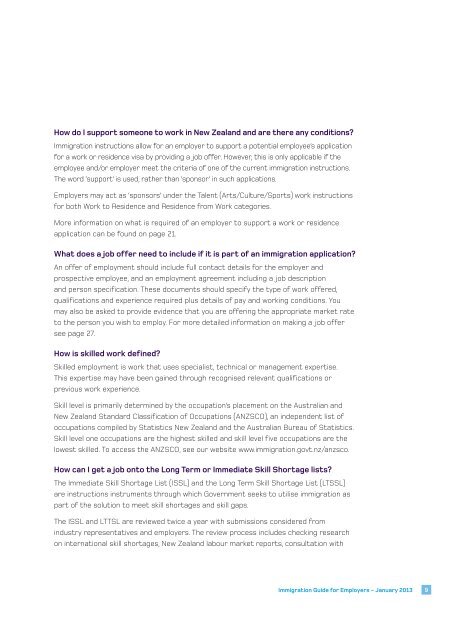
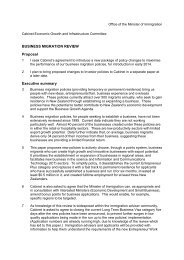
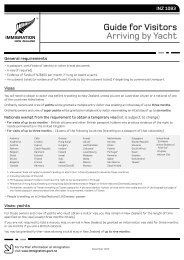

![Long Term Skill Shortage List PDF [200KB] - Immigration New Zealand](https://img.yumpu.com/15876707/1/184x260/long-term-skill-shortage-list-pdf-200kb-immigration-new-zealand.jpg?quality=85)
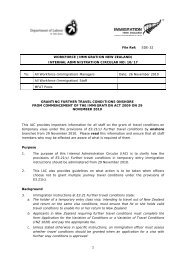

![New Zealand Residence Programme Fact Sheet PDF [161KB]](https://img.yumpu.com/14040475/1/184x260/new-zealand-residence-programme-fact-sheet-pdf-161kb.jpg?quality=85)
